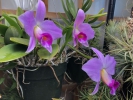|
|
|
|
|
| |
Flasks of
Cattleya praestans 'SB Orchid Estate' × 'MC8155' |
|
| |
|
|
| |
| Number: |
TN9445 |
| Name: |
Cattleya praestans 'SB Orchid Estate' × 'MC8155'
|
| Type: |
outcross (What's that?) |
|
Click to Enlarge

Pod Parent Flowers |
Click to Enlarge

Pollen Parent Blooming Plant |
|
|
|
| |
Culture Notes from Donor: Pod parent plant: Temperature range Warm-Intermediate 87-64°F, cooler season Intermediate 83-60°F. The plant is grown indoors under full-spectrum LED lights, but also receives filtered light through a west window. Humidity is generally over 50 percent, but sometimes drops below 40 percent during Winter. I water the plant with reverse osmosis water supplemented with K-Lite fertilizer nearly every day. Basketed with rock.
Comments: Pod parent plant: Medium-sized plant. The donor bought the plant in October 2021 from Santa Barbara Orchid Estate. It blooms reliably on multiple leads in both Fall and Spring each year.
For additional origin/habitat information supplied courtesy of
Charles and Margaret Baker, see further below, near the bottom of this page.
|
Temperatures we attempt to use in the lab & greenhouse:
| For Species: |
|
Spring, Summer, Autumn: days average 77°F, nights 64°F; best fit is Intermediate 83-60°F
(Source:
Baker's Web OSC) |
| For Species: |
|
Winter: days average 69°F, nights 57°F; best fit is Cool 70-52°F
(Source:
Baker's Web OSC) |
| For Genus: |
|
Spring, Summer, Autumn, Winter: days average 83°F, nights 60°F; best fit is Intermediate 83-60°F
(
) |
|
About the name...
| Etymology of |
Cattleya |
|
Named in honor of William Cattley, English horticulturist in the 19th century.
(Source:
Pridgeon 1992) |
| Etymology of |
praestans |
|
From Latin "praestans" outstanding, grand.
(Source:
Mayr & Schmucker 1998) |
| Pronunciation of |
Cattleya |
|
KAT-lee-ya
(Sources:
Pridgeon 1992, Hawkes 1978) |
| Pronunciation of |
praestans |
|
PRY-stanz
(Source:
Hawkes 1978) |
|
If you would like to direct someone to this web page, please copy and paste this URL into your email:
http://troymeyers.com/d?019445
| Flask Information |
| Availability: |
The seeds have germinated in the mother flasks. |
| You should: |
Reserve flasks right now.
Please only reserve if you are committing to purchase the flasks when they are ready later.
We only make flasks for people who request them, so you must make a reservation for us to do the work. If you don't reserve now, there will likely not be enough flasks made to cover your later need. If you wait to reserve until after we begin reflasking into final maturing flasks, then you will lose your place in line. Otherwise, your original notification request acts as your place-holder, keeping you earlier in line. |
| Yield Estimate: |
180 plants (based on flask surveys done 06/27/2023 through 08/11/2023)
|
| Expected Flask Price: |
$40.00 per flask of 16 (min.) plants
Plants proliferate if crowded, so are planted more sparsely than usual.
|
|
You might also want to:
|
View the seed assay for this item.
View items of the same species.
View items of the same genus.
|
| Ordering Information |
| You are not currently logged in. |
|
You must be a registered user and be logged in to reserve a flask or place a notification request. Please log in:
|
|
|
|
|
|
| |
The origin/habitat information below is supplied courtesy of Charles and Margaret Baker
The following information is based on the name of the plant provided by the donor, and assumes that the name is correct. If the plant has been misidentified, then the following information may not be correct.
This text is copyrighted by the Bakers and may not be reproduced without permission.
ORIGIN/HABITAT: Brazil. Plants were originally found on southeast facing
slopes in east-central Espírito Santo. Plants grow in rather dense forests
of relatively small, saplinglike trees at 2300–2950 ft. (700–900 m). Later
reports, however, indicate that plants may grow at any elevation from
1950–3300 ft. (600–1000 m). The prevailing wind in the region is from the
southeast, which brings moisture laden air in from the nearby ocean. This
air cools as it is lifted over the south- and east-facing slopes which
causes very heavy rainfall during the day and large amounts of mist and
fog at night through most of the year. Fowlie (1980, 1982) reported that
the south-facing or shady side of the hills are sloped at 30–45. Orchids
grow on small trees that are usually 2–5 in. (5–13 cm) across by about 20
ft. (6 m) tall. Host trees support an abundance of mosses and lichens.
This species has also been reported from near Belo Horizonte in the state
of Minas Gerais. Most authorities, however, feel that these reports are
due to erroneous identifications of Laelia pumila.
More about this information and the Bakers...
|
|
|
| |
|
|
|